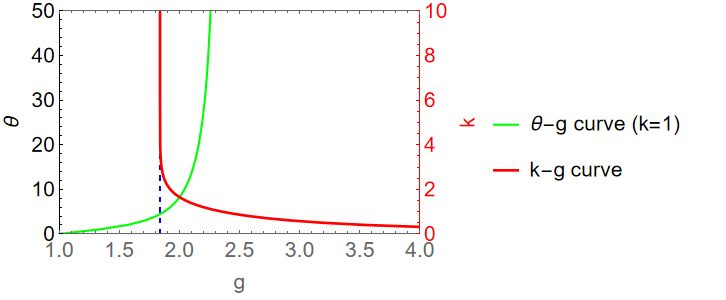This is a follow-up question of my previous post: How to combine several plots with different $x$ and $y$-axis?
gthres = 1/3 + (19 - 3 Sqrt[33])^(1/3)/3 + (19 + 3 Sqrt[33])^(1/3)/3;
data1 = {{E^0.609378, 10}, {E^0.609379, 8}, {E^0.609395,
6}, {E^0.610285, 4}, {E^0.61073, 3.8}, {E^0.611392,
3.6}, {E^0.612376, 3.4}, {E^0.613835, 3.2}, {E^0.615994,
3}, {E^0.619176, 2.8}, {E^0.62384, 2.6}, {E^0.630628,
2.4}, {E^0.640412, 2.2}, {E^0.654347, 2}, {E^0.663323,
1.9}, {E^0.673925, 1.8}, {E^0.686401, 1.7}, {E^0.70103,
1.6}, {E^0.718126, 1.5}, {E^0.738047, 1.4}, {E^0.761207,
1.3}, {E^0.788093, 1.2}, {E^0.819291, 1.1}, {E^0.855529,
1}, {E^0.897738, 0.9}, {E^0.94715, 0.8}, {E^1.005469,
0.7}, {E^1.075163, 0.6}, {E^1.160036, 0.5}, {E^1.266435,
0.4}, {E^1.406236, 0.3}};
datak1 = {{E^0.000355, 0.001}, {E^0.288254, 1}, {E^0.450301,
2}, {E^0.538749, 3}, {E^0.592586, 4}, {E^0.628792, 5}, {E^0.654981,
6}, {E^0.674948, 7}, {E^0.690774, 8}, {E^0.703694,
9}, {E^0.714485, 10}, {E^0.731594, 12}, {E^0.744646,
14}, {E^0.759428, 17}, {E^0.770506, 20}, {E^0.783981,
25}, {E^0.79363, 30}, {E^0.800917, 35}, {E^0.806631,
40}, {E^0.811241, 45}, {E^0.815042, 50}};
yminmax1 = MinMax@data1[[All, 2]];
yminmaxk1 = MinMax@datak1[[All, 2]];
datak1rescaled =
Transpose[{#, Rescale[#2, yminmaxk1, yminmax1]} & @@
Transpose[datak1]];
ListLinePlot[{datak1rescaled, data1},
GridLines -> {{gthres}, None},
GridLinesStyle -> Directive[AbsoluteThickness[1], Blue, Dashed],
PlotStyle -> {{Green},{AbsoluteThickness[2], Red}},
PlotLegends -> {"\[Theta]-g curve (k=1)","k-g curve"},
PlotRange -> {{1, 4}, {0, 10}}, LabelStyle -> 16, ImageSize -> Large,
Frame -> True, FrameLabel -> {{"\[Theta]", "k"}, {"g", None}},
FrameStyle -> {{Black, Red}, {Automatic, Automatic}},
FrameTicks -> {{Charting`FindTicks[yminmax1, yminmaxk1],
All}, {Automatic, Automatic}}]
The plot looks fine except that the range of the $\theta$-axis on the left is misleading: There's a short section below zero which I don't want. I tried several methods like "PlotRange -> {{1, 4}, {{0,50},{0, 10}}}", "PlotRange -> {{{1, 4},{None}}, {{0,50},{0, 10}}" etc. But none worked. Can someone help? Thanks in advance!



yminmax1toyminmax1 = {0, Max@data1[[All, 2]]}$\endgroup$yminmax1 = {.001, Max@data1[[All, 2]]}$\endgroup$